The pink-headed duck and crested shelduck are currently the world’s rarest ducks, if they survive at all – having gone decades without confirmed sightings. Among extant species, the Madagascar pochard and Brazilian merganser are exceptionally rare and endangered, but can still be found in the wild, with fewer than 50 and 250 mature individuals remaining, respectively.
In this report, we examine the rarest and most threatened duck species alive today, focusing on population estimates, primary threats, and current conservation measures. We begin with species that are still relatively numerous but declining, and move toward those on the very brink of extinction.
White-headed duck (Oxyura leucocephala)
- Conservation status: Endangered.
- Estimated population: 5,300-8,700 mature individuals.
- Range and habitat: Spain, North Africa, Central and Southwest Asia; inland saline lakes, lagoons, and marshes with emergent vegetation.
- Threats: Hybridisation with ruddy duck, habitat loss, drought, illegal hunting, entanglement in fishing nets, pollution.
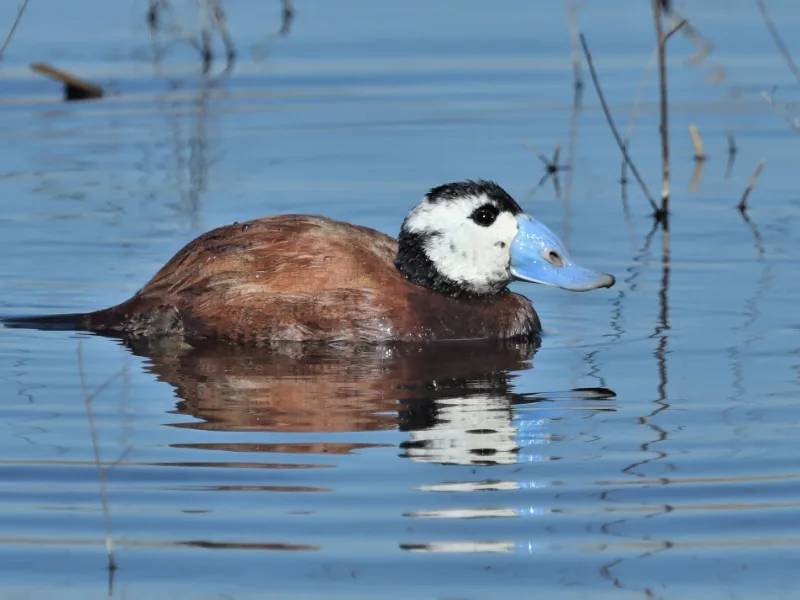
The white-headed duck is a stiff-tailed diving duck with a fragmented distribution from the Mediterranean to Central Asia. Once numbering over 100,000 birds globally, its population collapsed during the 20th century and is now estimated at 5,300 to 8,700 mature individuals. Major strongholds include Kazakhstan, Spain, and parts of North Africa, with significant declines in Turkey, Pakistan, and India. Though some local populations have shown recovery, particularly in Spain following conservation action, fluctuating water levels and gaps in coordinated monitoring continue to hinder accurate trend assessments.
The species faces a combination of severe threats. Hybridisation with the invasive North American ruddy duck (Oxyura jamaicensis) is considered the greatest long-term risk, especially in Western Palearctic countries. Habitat loss from wetland drainage, drought, water abstraction, and pollution has decimated breeding and wintering sites. Fishing nets, illegal hunting, and ingestion of lead shot contribute to direct mortality. While eradication efforts against ruddy ducks and active management in some regions have yielded results, the species remains highly vulnerable without continued coordinated protection of its fragmented range and improved wintering site data.
Maccoa duck (Oxyura maccoa)
- Conservation status: Endangered.
- Estimated population: 4,800-5,700 mature individuals.
- Range and habitat: Disjunct populations in East and Southern Africa; prefers nutrient-rich lakes and wetlands.
- Threats: Pollution, wetland drainage, water level instability, accidental mortality from gill nets, habitat degradation.
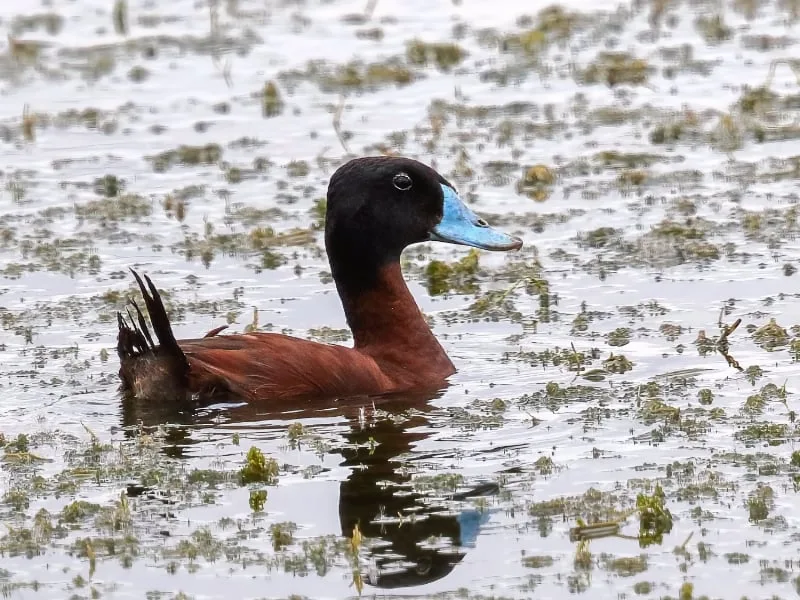
The Maccoa duck is a diving duck native to eastern and southern Africa, dependent on shallow, nutrient-rich freshwater wetlands for feeding and breeding. Once thought to be declining only in East Africa, recent data reveal that even the previously more stable southern population is undergoing rapid contraction. The East African population may now consist of fewer than 300 individuals, while the southern group, which comprises more than 95% of the global population, has declined by over 50% in just two decades. The total global population is currently estimated at 4,800 to 5,700 mature individuals, but with declines projected to continue, this number may soon fall even further.
The causes behind this decline remain imprecisely understood, but key threats include pollution that disrupts the duck’s benthic invertebrate food base, wetland drainage and conversion for agriculture, and abrupt changes in water levels due to deforestation and poor hydrological management. Accidental drowning in fishing nets also causes significant mortality, while competition from introduced benthic fish and invasive wetland plants further alters suitable habitat. Though some populations fall within protected areas, especially in East Africa, most of the southern African range lacks adequate protection. Without targeted wetland conservation, pollution control, and continued monitoring, the Maccoa duck faces an uncertain future.
Scaly-sided merganser (Mergus squamatus)
- Conservation status: Endangered.
- Estimated population: Fewer than 3,500 mature individuals.
- Range and habitat: Breeds along clear, fast-flowing rivers in southeastern Russia, northeast China, and North Korea; winters across central and southern China and parts of Southeast Asia.
- Threats: Habitat degradation, illegal hunting, fishing nets, disturbance, river engineering, pollution, and climate change.
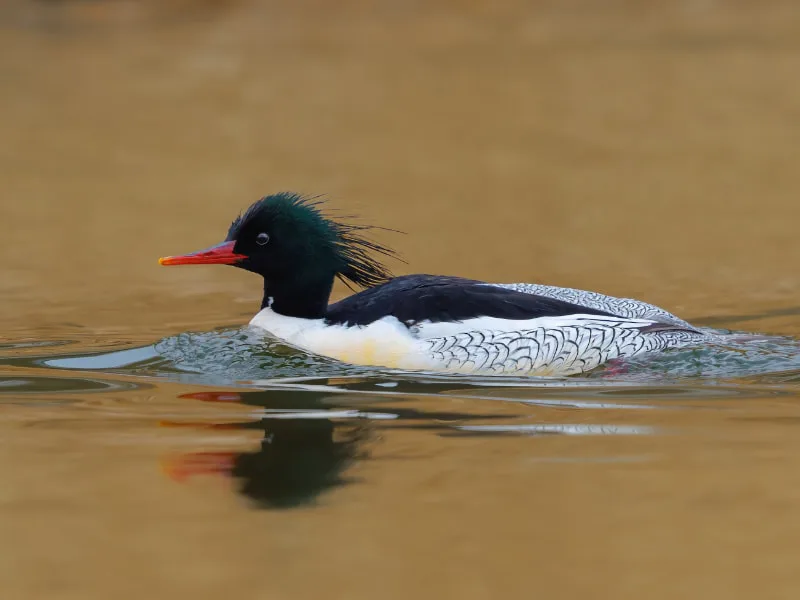
The scaly-sided merganser is a rare and striking duck specialized for life on fast-flowing rivers in remote forested landscapes of northeast Asia. Breeding populations are highly localized, with key concentrations in the Sikhote-Alin region (Russia) and Changbai Mountains (China). Satellite tracking has revealed long migratory journeys lasting over 40 days with regular stopovers, and birds show strong winter site fidelity. Most wintering individuals are found in central and southern China, particularly along the Yangtze River system. Although the global population is estimated at 2,400-4,500 mature individuals, continued declines suggest numbers may already have dropped below 3,500, even at the upper bound.
The species faces numerous threats across its life cycle. In Russia, logging close to rivers reduces nest site availability and alters stream flow, while in China and Korea, river damming, dredging, and pollution degrade critical habitat. Illegal hunting persists, especially during the poorly regulated spring season, and many mergansers drown in fishing nets, especially during moult and post-breeding dispersal. Heavy metal contamination on the wintering grounds may be contributing to low egg hatchability. While artificial nest box programs, outreach to hunters, and international cooperation have brought some success, protecting both breeding and wintering habitats remains vital to halt further population loss.
Meller’s duck (Anas melleri)
- Conservation status: Endangered.
- Estimated population: 1,300-3,000 mature individuals.
- Range and habitat: Eastern and northern high plateau of Madagascar; wetlands, streams, lakes and marshes in humid forested regions.
- Threats: Hunting, wetland loss, water degradation, introduced predators and hybrids, disturbance.
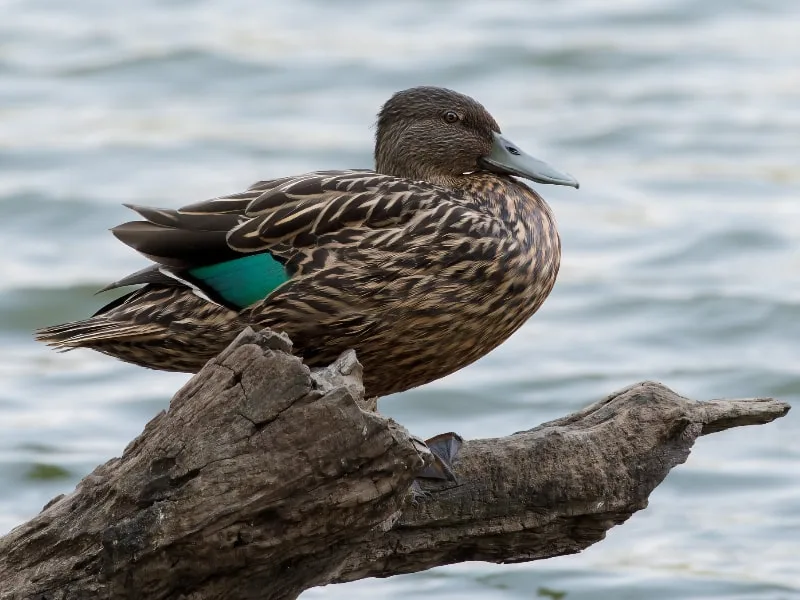
Meller’s duck is the largest endemic duck species in Madagascar, now surviving in scattered pockets across the island’s eastern and northern highlands. Though once considered common, its true numbers have always been low, and today the global population is estimated at just 1,300 to 3,000 mature individuals. The species is largely concentrated around wetland areas like Lake Alaotra, though even there the population is supplemented by large groups of non-breeders and remains vulnerable. All known birds appear to form a single, fragmented subpopulation with no regular breeding sites currently identified.
The species is in steep decline due to multiple converging threats. It is heavily hunted for subsistence, up to 450 birds are reportedly taken from Lake Alaotra alone each year, and is extremely sensitive to disturbance, often deserting territories when humans arrive. Madagascar has lost over half its wetlands since 1950, and this trend continues with expanding rice cultivation and deforestation. Siltation and water degradation further reduce habitat quality, while introduced fish and potential hybridisation with feral mallards add to pressures. Although 46% of the species’ range now falls within protected areas and some captive breeding efforts are underway, without urgent, landscape-scale wetland protection and hunting controls, the species faces continued decline.
Blue duck (Hymenolaimus malacorhynchos)
- Conservation status: Endangered.
- Estimated population: 1,500-2,500 mature individuals.
- Range and habitat: Forested river systems in the central North Island and western South Island, New Zealand.
- Threats: Introduced predators, habitat fragmentation, extreme weather events, human disturbance, and poor dispersal.
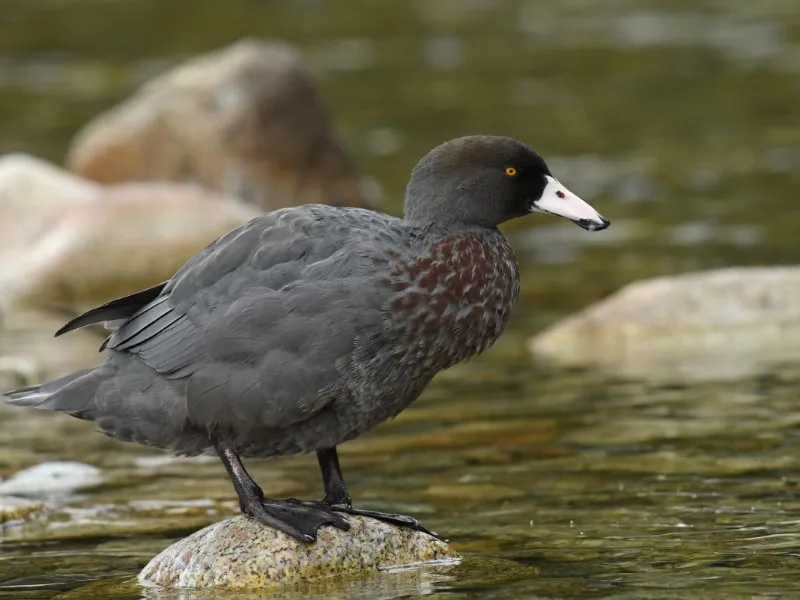
The blue duck is one of New Zealand’s most iconic and distinctive riverine species, now surviving in fragmented populations across turbulent, fast-flowing mountain streams. Once widespread, it has vanished from many areas following European colonization, primarily due to predation by introduced mammals such as stoats, cats, and rats. The current population is estimated at fewer than 2,500 mature individuals, with the largest subpopulation holding just over 100 pairs in Tongariro. In the absence of predator management, nesting failure can exceed 90%, and even in protected sites, the duck faces ongoing pressure from environmental fluctuations, stochastic events, and limited connectivity between river catchments.
Conservation interventions have proven effective, with intensive predator control, habitat restoration, and captive breeding programs resulting in encouraging population growth within secured sites. Notably, sites employing a mix of trapping and aerial 1080 poison have seen fledging success triple compared to unmanaged areas. The Whio Recovery Programme, bolstered by strong community and corporate partnerships, has secured more than 500 breeding pairs across eight “security sites.” Still, isolated populations remain vulnerable to weather extremes, habitat degradation, and the additive threats of climate change. Long-term persistence hinges on coordinated recovery efforts, expanded protection, and the continued framing of the blue duck as a flagship species for New Zealand’s river health.
Bernier’s teal (Anas bernieri)
- Conservation status: Endangered.
- Estimated population: 600-1,300 mature individuals.
- Range and habitat: Endemic to western Madagascar; mangrove wetlands and coastal shallows.
- Threats: Mangrove degradation, habitat fragmentation, subsistence and sport hunting, disturbance.
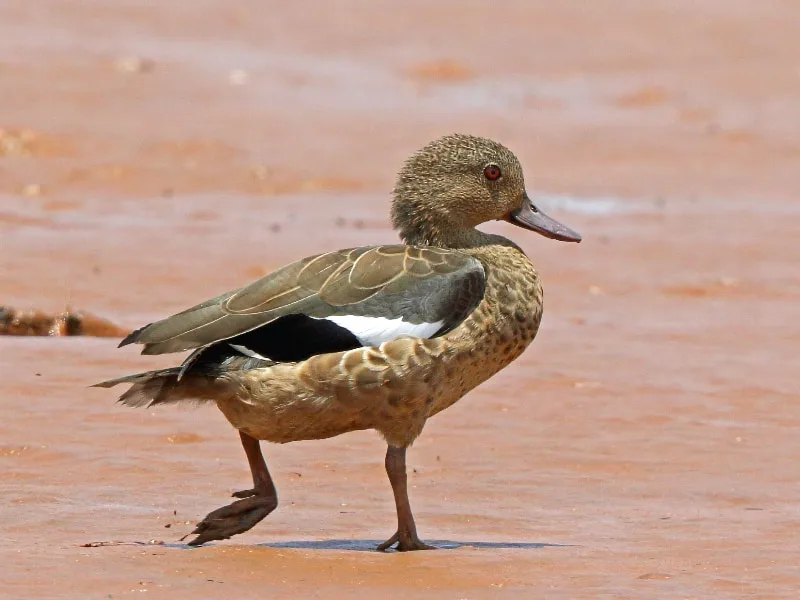
Bernier’s teal, also known as the Madagascar teal, is a small, elusive dabbling duck endemic to the mangroves and wetlands of western Madagascar. Its total population is estimated at 600 to 1,300 mature individuals, with the highest concentrations in the Mahavavy-Kinkony and Mangoky-Ihotry wetland complexes. These fragmented pockets of suitable habitat form the core of its range, which runs as a narrow coastal strip from the north-west to the central west of the island. The population trend appears to be declining, largely due to ongoing degradation of key wetlands and rising hunting pressure in both breeding and moulting areas. While some mangrove zones have gained protected status in recent years, the majority of known sites are still vulnerable to conversion, and the distribution suggests a single subpopulation increasingly at risk of fragmentation.
This mangrove-dependent duck is highly vulnerable to habitat loss, with much of its breeding and foraging range under pressure from logging, aquaculture, and rice expansion. Although recent conservation gains have increased the share of protected habitat, key sites remain exposed to degradation, hunting, and human disturbance. The species’s limited dispersal ability and preference for specific wetland conditions heighten the risk of fragmentation and local extinctions. As saline wetlands become increasingly isolated, Bernier’s teal now persists mainly in areas too marginal for agriculture. Ongoing conservation work, including protected area designation and ecological studies, is critical to ensuring the survival of this declining species.
Campbell teal (Anas nesiotis)
- Conservation status: Vulnerable.
- Estimated population: Fewer than 1,000 mature individuals.
- Range and habitat: Campbell Island group, New Zealand; coastal tussock, forested areas, peaty streams and wetland margins.
- Threats: Invasive predators, potential hybridization, disease, and climate events.

The Campbell teal is a small, flightless duck once reduced to a tiny remnant population on Dent Island, a rocky outcrop off Campbell Island in New Zealand’s subantarctic region. It went undetected for most of the 20th century and was rediscovered only in 1975. Thanks to intensive conservation efforts, including captive breeding and reintroduction, it now survives in three subpopulations: on Campbell Island, Whenua Hou (Codfish Island), and possibly still on Dent Island. The global population is estimated at fewer than 1,000 mature individuals, though precise numbers remain uncertain due to the bird’s elusive nature and lack of systematic surveys.
Although the population has increased dramatically since the 1990s, the species remains vulnerable. The accidental reintroduction of rats to Campbell or Whenua Hou could trigger a catastrophic decline. Other threats include severe weather events, oil spills, and potential hybridisation with the brown teal (Anas chlorotis), should the latter be introduced nearby. Conservation action has included the world’s largest rat eradication campaign and habitat protection. Continued monitoring and strict biosecurity measures are essential to preserve this fragile success story.
Hawaiian duck (Anas wyvilliana)
- Conservation status: Vulnerable.
- Estimated population: 700-1,000 mature individuals.
- Range and habitat: Restricted to Kaua’i and Ni’ihau, Hawaiian Islands; lowland wetlands, streams, ponds, and coastal marshes.
- Threats: Hybridisation with mallards, introduced predators, botulism, habitat degradation, climate change.
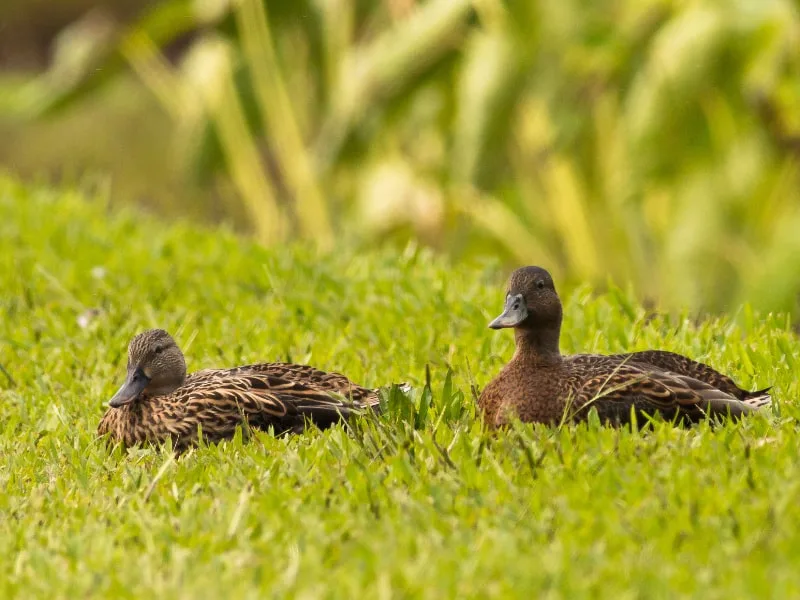
The Hawaiian duck, or koloa, is the only endemic dabbling duck remaining in the Hawaiian Islands. Once widespread, it now survives in its genetically pure form only on the islands of Kaua’i and Ni’ihau. Following a dramatic 20th-century decline due to hunting, habitat loss, and the introduction of invasive predators, its numbers have begun to recover, with an estimated 700 to 1000 mature individuals. Surveys on Kaua’i suggest a long-term upward trend, likely the result of wetland restoration, predator control, and the island’s absence of established mongoose populations.
Despite encouraging growth, the species remains highly vulnerable. The biggest historical threat has been genetic introgression through hybridisation with feral mallards (Anas platyrhynchos), especially following widespread releases in the mid-20th century. While this remains a concern, hybridisation rates appear stable on Kaua’i, and pure individuals still dominate. Current threats include avian botulism, predation by cats, dogs, and potentially mongoose, as well as habitat degradation from invasive plants, ungulates, altered hydrology, and sea level rise. Continued monitoring, predator control, habitat management, and firm restrictions on mallard introduction are essential to secure the future of this uniquely Hawaiian species.
Laysan duck (Anas laysanensis)
- Conservation status: Critically Endangered.
- Estimated population: 500-700 mature individuals.
- Range and habitat: Laysan Island, Midway Atoll, and Kure Atoll, Hawaiian Islands, USA.
- Threats: Disease, extreme weather events, habitat loss, climate change, and invasive species.
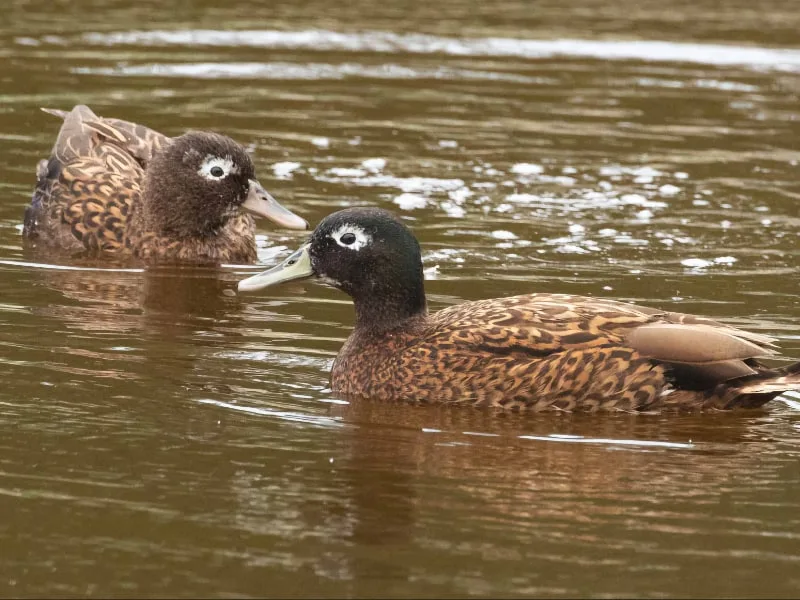
The Laysan duck is a non-migratory species once widespread across the Hawaiian archipelago, now confined to just a few low-lying islands. After being reduced to near extinction in the early 20th century due to habitat destruction by introduced rabbits, the population rebounded slowly on Laysan Island, reaching an estimated 521 birds in 2010. Since then, additional populations were established on Midway Atoll (starting with 42 birds in 2004-2005) and later on Kure Atoll (28 birds translocated in 2014). Despite successful breeding and growth at these sites, overall numbers remain low, fluctuating between 500 and 700 mature individuals. Major population setbacks were caused by a tsunami in 2011 and recurring annual outbreaks of avian botulism, the worst of which killed 40-50% of ducks on Midway in 2008.
The species’ life history and habitat needs make it particularly vulnerable to environmental stress. Laysan ducks nest in dense vegetation and rely on freshwater seeps and wetland margins for raising young. On Laysan, clutch sizes are smaller and breeding is delayed compared to Midway, likely due to food scarcity and habitat constraints. While birds at new sites show greater fecundity, low duckling survival remains a challenge. The Laysan duck’s fragile status is compounded by its limited distribution, vulnerability to climate-induced sea-level rise, and dependence on habitat quality. Conservation measures now include habitat restoration, population monitoring, and careful translocations to create additional self-sustaining populations on predator-free islands.
Baer’s pochard (Aythya baeri)
- Conservation status: Critically Endangered.
- Estimated population: 150-700 mature individuals.
- Range and habitat: East and Southeast Asia; prefers freshwater wetlands with dense aquatic vegetation.
- Threats: Habitat loss, illegal harvesting, wetland degradation, low protection coverage.
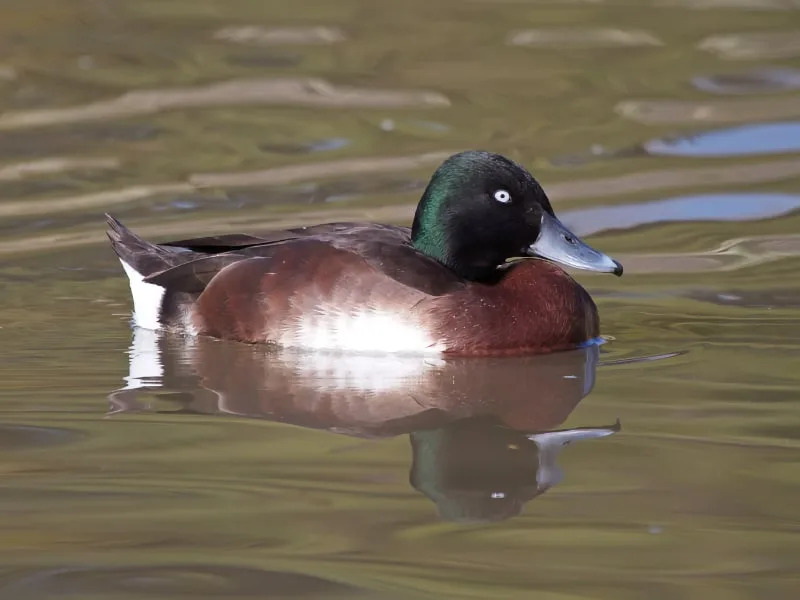
Baer’s pochard is one of Asia’s most threatened diving ducks, with a wild population estimated at only 150 to 700 mature individuals. Once widespread across eastern Russia, northeastern China, and Southeast Asia, its range has contracted sharply over the last few decades. Remote-sensing and field survey data from 2014-2021 confirm a major southward shift in the breeding distribution, with all six confirmed sites now located in central-eastern China, up to 1,400 km (870 mi) south of the IUCN’s previously mapped breeding range. At the same time, wintering grounds have shifted up to 800 km (500 mi) northward, with new sites found as far north as Beijing and Tianjin. Unlike most migratory ducks, Baer’s pochard now uses many sites year-round, with breeding, stopover, and wintering occurring at the same locations.
The species faces a long list of threats, from widespread habitat destruction and egg collection to bycatch, disturbance, and pesticide use. Over 90% of its predicted suitable habitat falls outside protected areas, and many of its key sites lie near expanding urban zones. Conservation actions include captive breeding (especially in Europe and North America), habitat protection efforts through the EAAFP, and detailed monitoring via satellite and species distribution models. However, its long-term survival will depend on broader wetland conservation, stronger cross-border collaboration, and integration of urban and agricultural landscapes into conservation planning.
White-winged duck (Asarcornis scutulata)
- Conservation status: Critically Endangered.
- Estimated population: 150-450 mature individuals
- Range and habitat: Scattered across India, Myanmar, Sumatra (Indonesia), and Cambodia; prefers slow-flowing or stagnant forest wetlands.
- Threats: Habitat loss, degradation, hunting, and disturbance.

The white-winged duck was once widespread across the lowland wetlands and forests of South and Southeast Asia, but today it survives in only a few scattered, highly fragmented populations. In India, once considered a stronghold, recent surveys have documented as few as 24 individuals across a handful of sites, with an estimated maximum of 150 mature birds remaining. Myanmar now likely supports the largest population, especially in the Hukaung Valley and Htamanthi Wildlife Sanctuaries, though ongoing deforestation and gold mining pose escalating threats. In Cambodia and Sumatra, only isolated pockets remain, with fewer than 50 and 60 mature birds estimated respectively. The species is likely extinct in Vietnam, Laos, Peninsular Thailand, Malaysia, and Java.
This duck’s decline is largely due to the destruction of its riverine and swamp forest habitats, cleared for agriculture, logging, or oil palm plantations, and to persistent hunting and egg collection. It depends heavily on large, undisturbed forest wetlands with old-growth trees for nesting in hollows. Captive breeding attempts have been made, particularly in Europe, but the global captive population is also in sharp decline. While scattered conservation actions are underway, including a species recovery plan in Assam (India) and reintroduction trials in Thailand, the white-winged duck remains perilously close to extinction and urgently requires coordinated protection and habitat restoration across its range.
Brazilian merganser (Mergus octosetaceus)
- Conservation status: Critically Endangered.
- Estimated population: 150-250 mature individuals.
- Range and habitat: Isolated stretches of shallow, fast-flowing rivers in central Brazil; historical records from Argentina and possibly Paraguay.
- Threats: River damming, pollution, deforestation, diamond mining, agriculture, habitat fragmentation.

The Brazilian merganser is one of the most threatened waterfowl in the world, confined today to fragmented headwater rivers in Brazil’s Cerrado and Atlantic Forest regions. Once more widespread across parts of Argentina and Paraguay, it has disappeared from much of its range and is now mostly restricted to Serra da Canastra in Minas Gerais, where recent surveys suggest 140-200 mature individuals may survive. Additional small groups persist in areas like Jalapao (Tocantins) and Chapada dos Veadeiros (Goias), but the species is now gone from many historical sites. In total, the population is estimated to lie between 150 and 250 mature individuals.
This striking, river-dependent duck is extremely specialized: it inhabits clear, rocky rivers with rapids, using long stretches of undisturbed habitat for foraging and nesting. Its decline has been driven by habitat degradation from dam construction, diamond mining, agricultural runoff, and deforestation. Although some birds tolerate unforested rivers, pressures outside protected areas are growing. Conservation initiatives now include population monitoring, river protection, environmental education, and a growing captive-breeding program. The Itatiba Zooparque in Brazil led the first successful captive breeding in 2011 and continues to expand the program. In 2023, a founding group was sent to Prague Zoo, which saw the hatching of its first five ducklings in 2025, offering a rare beacon of hope for one of South America’s most elusive waterfowl.
Madagascar pochard (Aythya innotata)
- Conservation status: Critically Endangered.
- Estimated population: 40-50 mature individuals.
- Range and habitat: Northern Madagascar, limited to a cluster of volcanic lakes near Bemanevika; prefers shallow freshwater lakes and marshes with some emergent vegetation.
- Threats: Habitat degradation, introduced fish, high chick mortality, limited food supply, and extreme vulnerability due to tiny range.
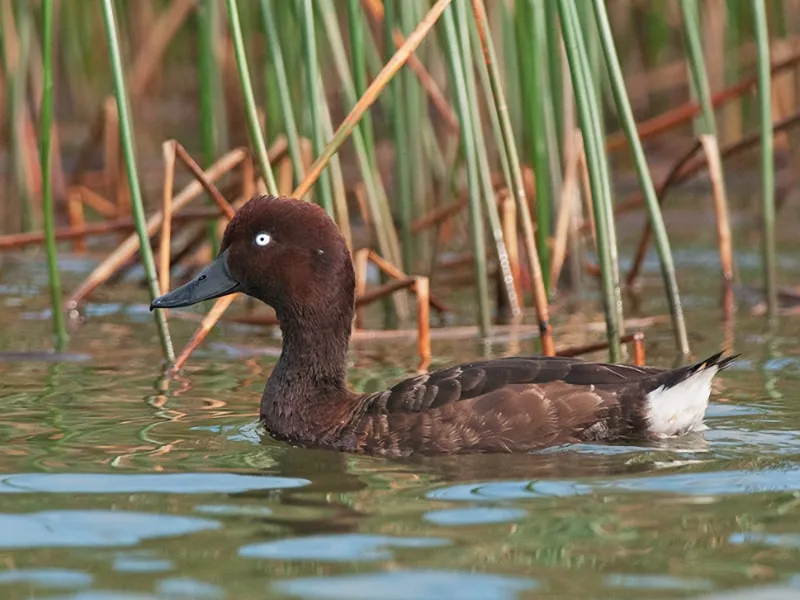
Thought to be extinct for over a decade, the Madagascar pochard was rediscovered in 2006 when a tiny population was found at Lake Matsaborimena, a remote volcanic lake in northern Madagascar. Once widespread in the Lake Alaotra basin, the species suffered a dramatic decline through the 20th century due to wetland conversion for agriculture, sedimentation, and predation from introduced fish species. After its rediscovery, conservationists found the remaining population restricted to just a few highland lakes, with an area of occupancy as small as 4 sq km (1.54 sq mi). Breeding at the rediscovery site has been inconsistent, with frequent years of total nesting failure due to poor food availability and high chick mortality.
In response, a large-scale conservation effort led by Durrell Wildlife Conservation Trust and WWT established a captive breeding program and began reintroduction at Lake Sofia in 2018. While this new site has seen some success, including fledging chicks in 2020, the population there remains entirely dependent on supplemental feeding and habitat management. The global wild population is still estimated at only 40-50 mature individuals, with most confined to a single lake system vulnerable to climate, disturbance, and ecological imbalance. The species’ survival depends on continued intensive intervention and long-term wetland restoration.
Crested shelduck (Tadorna cristata)
- Conservation status: Critically Endangered (Possibly Extinct).
- Estimated population: Fewer than 50 individuals.
- Range and habitat: Historically from eastern Russia, the Korean Peninsula, and northeast China; associated with coastal wetlands and possibly inland or montane lakes.
- Threats: Habitat loss, hunting, misidentification, and development pressures.
The crested shelduck is the rarest and most mysterious bird in Asia, known from a handful of confirmed sightings, the last in 1964 when a small group was observed on islands near Vladivostok. A possible North Korean record from 1971 has since been questioned, and more recent reports from northeast China remain unverified. The species was historically thought to occur in low densities across coastal and possibly inland areas of eastern Asia, with speculative breeding in remote montane or volcanic lakes. It has not been conclusively recorded in over half a century, though its elusive nature and the lack of fieldwork in parts of its range have sustained hope for its survival.
Widespread publicity efforts during the 1980s and early 1990s, including the distribution of hundreds of thousands of illustrated leaflets across East Asia, produced several leads but no confirmed sightings. If it survives, the population is likely critically small and highly susceptible to extinction through chance events or further habitat degradation. Coastal development, historical overhunting, and lack of recent field access in countries like North Korea have all contributed to its decline and ongoing obscurity. Despite the absence of verifiable records in recent decades, continued search efforts are recommended, particularly in under-surveyed regions of northeast China, eastern Russia, and the Korean Peninsula.
Pink-headed duck (Rhodonessa caryophyllacea)
- Conservation status: Critically Endangered (Possibly Extinct).
- Estimated population: Fewer than 50 individuals, if any survive.
- Range and habitat: Lowland wetlands of India, Bangladesh, Myanmar, and rarely Nepal; favored marshes, oxbow lakes, and densely vegetated swamps.
- Threats: Habitat loss, drainage of wetlands, historical hunting and egg collection, and commercial specimen trade.
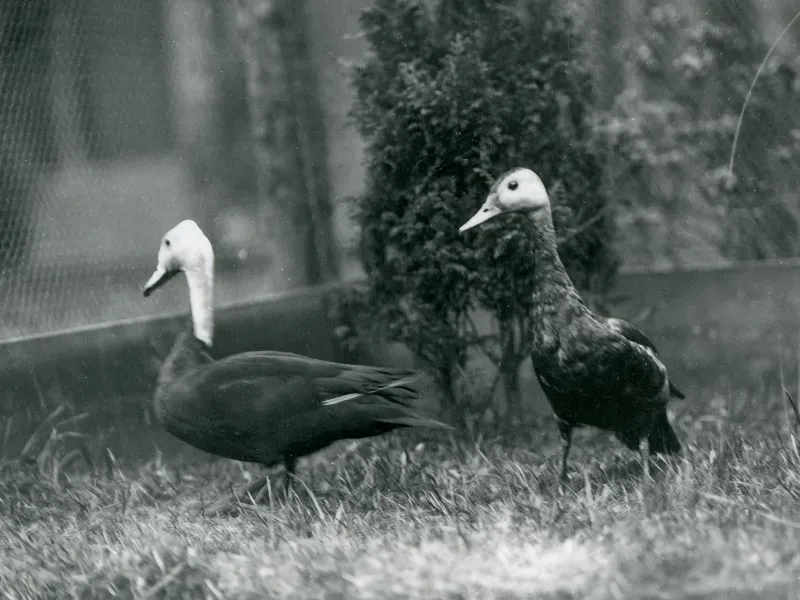
The pink-headed duck has long been one of Asia’s most enigmatic birds. Although often listed as last seen in 1949, the final confirmed record was a male captured in Bihar, India, in 1935. All later reports remain unverified and are now widely considered doubtful. Once locally distributed in northeast India and parts of Bangladesh and Myanmar, it was always considered rare, often solitary or in small groups, and highly specialized in habitat use. Intensive wetland conversion during the colonial era, combined with year-round hunting and an ill-timed commercial incentive for live birds in the 1920s, may have sealed its fate. A 2017 study concluded that the species likely disappeared from the wild around 1935-1938, with the final captive individual dying in 1948.
Genomic evidence from museum specimens confirms that Rhodonessa caryophyllacea represents a distinct and ancient lineage of pochards, having diverged from its closest relatives over 2.8 million years ago. Its effective population size remained chronically low, between 15,000 and 25,000 individuals, for at least 100,000 years, likely due to niche specialization in seasonally inundated, densely vegetated wetlands. The species may have been partly nocturnal, a trait suggested by field observations and supported by its carotenoid-pigmented plumage, a rare feature in ducks. Although surveys in Myanmar’s Kachin State between 2003 and 2014 yielded no definitive evidence, credible local accounts and habitat modeling continue to justify its inclusion among the world’s “most wanted” lost birds. The search persists, sustained by a combination of scientific rigor and grassroots persistence, despite decades of disappointment.
Future outlook
The future of the world’s rarest ducks remains deeply uncertain. Some, like the pink-headed duck or crested shelduck, may already be lost forever, while others teeter on the brink despite heroic conservation efforts. As threats like habitat loss, invasive species, pollution, and climate change continue to escalate, more species may find themselves added to this list. At the same time, the progress seen in a few recovery stories offers a glimpse of hope, reminding us that with the right action, decline can be reversed. This list is not static; it is a call to attention, a living document of both loss and potential survival.
Further reading
